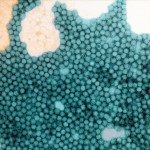Lien vers Pubmed [PMID] – 9645992
Clin Diagn Virol 1998 Apr;9(2-3):107-13
BACKGROUND: Poliovirus (PV) is the etiologic agent of paralytic poliomyelitis, which is sometimes followed, after decades of clinical stability, by new symptoms, including progressive muscular atrophy, collectively known as the post-polio syndrome. This raises the question of possible PV persistence in post polio patients.
OBJECTIVE: To test the capacity of PV to establish persistent infections in human cells, three models were developed.
STUDY DESIGN: This review focuses on the viral and cellular parameters involved in persistent PV infection.
RESULTS: Many PV strains, which are generally lytic in primate cell lines, are able to establish persistent infections in human neuroblastoma cells. During persistent infection, PV mutants (PVpi) are consistently selected, and several of their capsid substitutions occur at positions known to be involved in PV-PV receptor interactions. PVpi have a particular property: they can establish persistent infections in non-neural HEp-2 cells. PV can also persistently infect primary cultures of human fetal brain cells and the majority of cells which survive infection belong to the neuronal lineage.
CONCLUSIONS: The results obtained with the three models of persistent PV infection in human cells suggest that several mechanisms are used by PV to establish and maintain persistent infections in neural and non-neural cells. The interactions of the virus with its receptor seem to be a key-step in all cases. In the future, the elucidation of the etiology of the post-polio syndrome will require the characterization of PV sequences having persisted for decades in post-polio patients.
